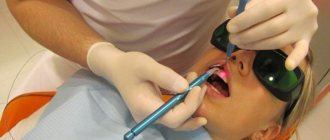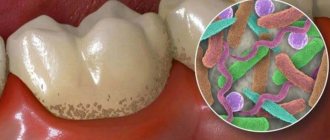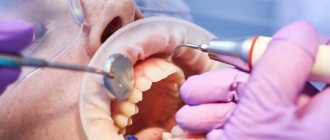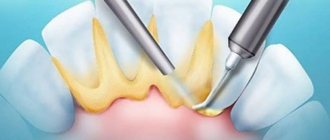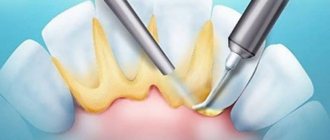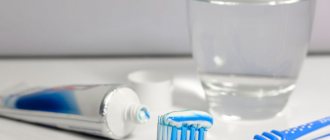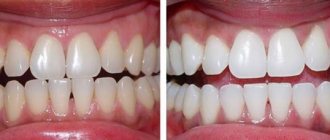Teeth cleaning with ultrasound is an innovative alternative to the classic procedure of mechanical removal of tartar.
Its advantage is minimal damage to tissues, thorough treatment of the oral cavity with better quality of teeth cleaning. Let's look at the new ultrasonic treatment technique in more detail, taking into account all its pros and cons, price and reviews.
Preparation for the procedure
First of all, the specialist examines the client and assesses whether the condition of his teeth and gums meets all the requirements and restrictions of this procedure.
The doctor must ask about any contraindications.
Attention! Since many of them are not detected during examination, pay close attention to the relevant section of the article.
Some clinics use a special safe solution, after applying which the tartar appears on the tooth enamel in a brighter shade. This method makes the specialist’s work easier.
Laser technologies in professional oral hygiene
Laser teeth cleaning is an innovative technique in dentistry that allows you to non-contactly clean the tooth surface from massive dental plaque and tartar. The effectiveness of this procedure is one hundred percent. The patient does not experience any discomfort. Tooth enamel that has darkened or yellowed over time due to various environmental factors (food, drinks, tobacco smoke) becomes significantly whiter. In addition, laser treatment of the oral cavity destroys all pathogenic microflora and leaves no chance for the appearance of carious processes. Laser removal of dental stones is the safest and most effective method that does not damage the hard tissues of the tooth and completely eliminates the problem. The entire procedure takes, on average, 20 minutes. But there are also certain contraindications:
- visitors under 18 years of age;
- pregnancy;
- problems with the cardiovascular system;
- bronchitis and asthma in the period of exacerbation;
Main stages of ultrasonic processing
With the exception of certain details, ultrasonic removal of tartar occurs according to the following method.
Brushing teeth with a skyler
The first stage is a rough cleaning of the teeth, which is done using a professional instrument - a scaler (scaler, scaler).
Its operating principle is based on the oscillatory movements of ultrasonic waves (up to 20 thousand hertz):
- Skyler destroys tartar and other deposits.
- The dirt is immediately washed away by the pressure of water with a medicinal composition. The dentist tilts the tip of the device, directing the stream along the surface being treated so that it does not destroy the enamel.
- Then the moisture is pumped out with a saliva ejector.
This completes the first stage. Depending on the number of teeth cleaned, it takes about 40 minutes.
The process of removing stones with a skyler
Polishing
After rough processing, more precise correction occurs using the polishing method. The purpose of this stage is to remove residual dirt, smooth the enamel and whiten the teeth.
There are two polishing techniques:
- Mechanical - using brushes and paste to treat the space between the teeth, as well as strips - strips with a solution of sodium carbonate, which are glued to the surface and after a while removed along with the remnants of foreign elements separated from the enamel;
- Hardware - by supplying a stream of water with an abrasive gel, while the Air Flow device polishes teeth better, but is ineffective for heavy deposits on the enamel that it cannot remove.
Polishing your teeth takes approximately 15 minutes.
Teeth polishing using the Air flow method
Mechanical teeth polishing
Fluoridation
At the fluoridation stage, at the request of the customer, a strengthening gel is rubbed into the enamel. Due to fluoride, it promotes the rapid restoration of weakened tooth surfaces in places with worn enamel and prevents infection.
Important! Typically, all 3 stages of the procedure are completed in one visit to the dentist. Their total duration is adjusted depending on the degree of neglect of tartar, but usually does not exceed one hour.
Fluoride teeth strengthening procedure
How to preserve the results of dental plaque removal for a long time?
In order for the positive results of cleaning to last for a long time after removing plaque and tartar, you need to learn how to properly care for your teeth. Here are the recommendations that dentists give to their patients:
- Choose and use in dental and oral hygiene the brush and paste that suits you - your type and condition of tooth enamel;
- Brush your teeth at least twice a day - before breakfast and before bed. Try to rinse your mouth after every meal; • Brush your teeth in a circular motion for 3-5 minutes;
- Use rinses and dental floss to remove plaque from interdental spaces and other places in the mouth that are difficult to clean with a regular brush;
- Teeth need to be brushed from all sides, in addition, the tongue and gums need to be cleansed;
- Try to drink coffee and tea less often, and it’s better to quit smoking altogether. It is these habits that contribute to the rapid formation of pigmented plaque.
And of course, don’t forget that professional dental plaque removal is a procedure that should be carried out at least twice a year!
Actions after the procedure
After ultrasound therapy, a patient with an incorrect bite must be given a pause, during which he does not put on braces.
If after the session it is planned to continue dental treatment, the patient is given several days of rest to restore areas with thinned enamel.
Then the doctor begins filling or installing dentures.
After ultrasound therapy, a patient with a malocclusion must be given a pause, during which he does not put on braces. This is also required to restore the enamel.
Also after therapy, slight bleeding of the gums is possible. In this case, the dentist takes action to stop it.
The regularity of ultrasonic teeth cleaning should not be in question
Why should the procedure be regular and how quickly do new plaques form? New tartar can appear as a result of improper oral care and poor brushing. In some cases, it would be a good idea to purchase special chewing gum, oral foam, an apple, or use floss or a special rinse after meals, especially for smokers and coffee lovers. These products are convenient in cafes and outside the home. However, professional oral hygiene twice a year is mandatory. Unfortunately, not everyone adheres to these simple rules in everyday life. Then tartar accumulates on the teeth and causes periodontitis. An opportunity to eliminate it is a trip to the dentist.
Regular ultrasonic teeth cleaning helps:
- maintain dental aesthetics, which guarantees an attractive smile. The dentist will clean your teeth with ultrasound, polish their surface, which will restore their natural color and allow you to identify possible hidden carious lesions, thereby saving you from pain and complications;
- carry out effective dental treatment, since microorganisms living on the surface of tartar reduce the immunity of the oral cavity and the effectiveness of the process of eliminating dental diseases. It should be remembered that plaque can cause poor fastening of fillings and can reduce the long-term and reliability of overall treatment, being the main factor in the development of recurrent caries.
- maintain the health of the gums and supporting tissues of the teeth, prevent the development of diseases such as gingivitis and periodontitis. Thanks to ultrasonic teeth cleaning, healthy oral microflora is maintained. Thus, pathogenic microorganisms do not enter the gastrointestinal tract and do not settle as infectious foci in the heart and joints of the body.
How does the procedure work and how long does it take?
The duration of the procedure depends on the number of teeth being treated and the degree of contamination with foreign matter. On average, you will need to be in the doctor's office for about 40 minutes. During this time, the dentist will clean your teeth with ultrasound using a scaler with a special attachment. Finally, the teeth will be treated with polishing agents. This will consolidate the effect and allow you to keep your teeth clean longer in the future. The main rule is to maintain a hygiene regime after cleaning your teeth with ultrasound, to properly and competently care for them, following the recommendations of your dentist.
Will ultrasonic teeth cleaning cause harm to the body?
The procedure for removing tartar using ultrasound is absolutely safe, but it has certain contraindications. It is not suitable for patients with acute respiratory infections, bronchitis, and asthma. It is especially recommended in the presence of implants and in patients with orthopedic structures, as well as in adolescents during the natural change of bite and in patients with periodontitis.
Service cost
Offers for dental correction with ultrasound are provided in private dental clinics. It is not included in the mandatory list of free procedures.
The average cost of one course varies between 1500-3000 rubles. The difference in price is due to the marketing policy of dentistry and additional actions, for example, the need for anesthesia.
In addition to complete cleaning, you can order cleaning of one or more teeth. In this case, you will have to pay from 100 to 150 rubles to clean each one.
Which plaque and stone removal method should I choose?
The procedure should be chosen by a dentist who takes into account the following factors:
- volume of tartar and plaque;
- quality of teeth;
- the presence of orthopedic structures, crowns, fillings, veneers, lumineers;
- individual wishes of the patient.
Dentistry "Zuub.rf" offers a full range of professional teeth cleaning from tartar and plaque. Effect the first time, without pain or discomfort, at an affordable price. Sign up for an initial consultation with a specialist to decide on the type of service and other important nuances of professional hygiene.
Advantages and disadvantages of ultrasound therapy
Thorough treatment of all root canals is the main advantage of ultrasonic teeth cleaning
The most important advantage of the service is the tangible cosmetic effect.
After the session, the patient is completely free of plaque in any part of the tooth surface. His teeth become brighter due to the whitening effect.
Unlike alternative methods of mechanical and chemical action, ultrasonic vibrations are not harmful to enamel and gums, and the procedure itself is quick and does not hurt.
Modern hardware ultrasound technologies have the following advantages:
- thorough treatment of all root canals;
- smoothing the relief surface of the enamel;
- correction of teeth shade in smokers;
- teeth whitening effect.
Unfortunately, the technique is not without a number of disadvantages:
- the presence of a large number of contraindications;
- the likelihood of mechanical injuries to dentin;
- high cost of treatment;
- Ultrasonic cleaning does not provide permanent results, so re-treatment may be required after one or two years.
The extent to which the benefits of ultrasound therapy outweigh its negative aspects depends on the professionalism of the dentist. Therefore, when making an appointment, pay attention to the reviews and qualifications of the doctor who will clean your teeth with ultrasound.
Causes of deposits on teeth
When dental plaque forms, the reasons for this phenomenon can be identified as follows:
- Using toothpastes that do not meet all requirements.
- Brushing your teeth with a soft brush, which does not cope 100% with its task.
- Low content of vegetables, fruits and other solid foods in the diet.
- The diet is dominated by thermally processed food, which easily gets clogged between the teeth.
The most important reason for the appearance of deposits on teeth is poor oral hygiene or incorrect teeth cleaning technique. It is important to know that the teeth brushing procedure should last from 3 to 5 minutes, only then can you effectively get rid of all deposits.
How harmful can a service be?
A procedure approved by the medical community cannot be harmful by definition.
However, the method of ultrasonic cleaning of enamel requires a careful assessment of the condition of the teeth before starting treatment.
If the doctor misses the presence of contraindications or violates the order of work, the use of the device may harm the client’s health:
- cause damage to the enamel when it is weakened;
- injure the gums and cause bleeding.
More serious damage can be caused to the patient's body if he does not notify the dentist about existing contraindications.
Attention! Persons with pacemakers should be especially vigilant. Ultrasonic vibrations can damage the device that helps the heart function.
It is clear that the consequences of such treatment are not just harmful, but pose a mortal danger.
What are the benefits of a therapeutic and cosmetic session?
The correction procedure has a multifaceted beneficial effect:
- Under the influence of an ultrasonic wave, hard foreign deposits are broken down over the entire surface, including the space under the gums. This result is not available using similar methods.
- Along with the cleansing effect, the enamel whitens, which acquires a natural shade - softer and more natural than after other corresponding procedures.
- After cleaning with the device, the doctor will be able to quickly identify pathologies of the tissues of the interdental space and gums.
- The procedure is painless and much faster than other methods.
- Cleaning helps during periodontal treatment and fillings. It is often recommended to remove deposits before prosthetics.
These are only the main results that can be achieved after completing the course of treatment. The beneficial qualities of the procedure are not limited to this.
Contraindications
Innovative teeth cleaning is not suitable for everyone.
The list of contraindications includes:
- Ultrasonic teeth cleaning is not suitable for everyone; there are contraindications
installed pacemakers;
- arrhythmia of the heart muscle;
- dental implants, including crowns (the doctor avoids them during cleaning);
- asthma;
- the presence of diseases of the digestive system;
- increased sensitivity of teeth;
- age under 18 years;
- Chronical bronchitis;
- tuberculosis;
- acute respiratory infections and acute respiratory viral infections in the acute or chronic stage;
- HIV;
- oncology;
- frequent bleeding in the mouth;
- allergy to components used during ultrasonic cleaning;
- liver damage, in particular all forms of hepatitis;
- pregnancy and breastfeeding period.
In addition to the listed factors, there are individual characteristics of the body, after studying which the dentist may refuse to perform the procedure. In this case, you should choose an alternative option for whitening or removing tartar.
Types of Tartar
Tartar has its own classification - according to the field of education. Based on this feature, mineralized deposits are divided into two types:
- Subgingival calculus. Deposits accumulate under the edge of the gums, in the area of the gum pockets. A characteristic feature of subgingival tartar is its increased hardness. Mineralized subgingival deposits can cause an active inflammatory process in the periodontium (soft tissues of the oral cavity) and lead to gingivitis or periodontitis. It is impossible to remove subgingival stone at home: only a dentist can remove deposits in this area;
- Supragingival tartar forms above the gum level and is therefore clearly visible on the teeth. It can become stained from contact with food, and in smokers it has a distinct yellow or brown color. Supragingival tartar harms the healthy state of enamel, increases the risk of caries and, of course, spoils the appearance of teeth. It needs to be removed urgently, because the longer the stone is on the teeth, the denser and harder it becomes.
Symptoms such as the appearance of bad breath, discoloration of the gums, heavy plaque on the teeth after eating, and roughness of the teeth may tell you that tartar has formed on your teeth. If you observe such signs in yourself, be sure to contact the dentist for tartar removal and professional oral hygiene!
The most common questions
Does the procedure require pain relief?
Of course, this is the question that primarily concerns patients at the dental clinic. Unlike outdated mechanical cleaning technology, ultrasound does not cause discomfort, so the average client will not need pain relief.
Anesthesia, in its mildest forms, may only be required when treating the subgingival area and if the patient has sensitive teeth.
Is it possible to remove tartar if you have untreated caries?
Ultrasound cleaning can be done for caries. The presence of a carious cavity in a tooth does not affect the operation of the device in any way. An infectious disease is not a contraindication for ultrasonic cleaning. On the contrary, during complex dental treatment, dentists often begin work by removing stones and only then begin to treat caries.
Is the device capable of removing stones under the gum?
Subgingival tartar is a dangerous defect, the damage of which sometimes leads to periodontitis. Fortunately, Skyler can remove it. The device will not only thoroughly clean the treated area, but also carry out ultrasonic polishing of the root surface.
Ultrasonic tartar cleaning - before and after the procedure
Ultrasound removal of dental plaque: features, stages and prices
Ultrasound removal of dental plaque is a modern and highly effective method of oral hygiene. Ultrasound will help:
- Carry out the removal of supragingival and subgingival tartar;
- Quickly remove pigmented plaque;
- Eliminate soft microbial plaque.
Removing dental plaque is a procedure that is carried out in three stages. Below we will tell you in detail how the process of removing dental plaque with ultrasound will take place in the dentist’s office.
STEP 1: Ultrasound removal of plaque and tartar
Ultrasound removal of dental plaque is carried out using special equipment - ultrasonic scalers.
Scalers can be either a separate device or part of a dental unit. The main working element of the scaler is its tip with a metal attachment. The tip of this metal nozzle vibrates at high frequencies in the ultrasonic range. Also, water is supplied through the nozzle, which washes away decayed dental plaque from the patient’s mouth and is immediately removed with a saliva ejector.
